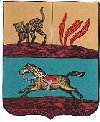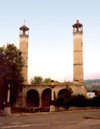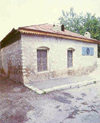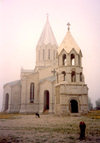| Shusha
(Shushi) |
Azerb.com
|
| |
|
 Shusha
(Shushi for the Armenians) is a small and picturesque town located near
the Dashalti river, just 10 km south of Nagorno-Karabakh's
main city, Xankandi (Stepankert). It was
founded in 1752 by Panah Khan Javanshir, a renegade general of the persian
army.
Shusha
(Shushi for the Armenians) is a small and picturesque town located near
the Dashalti river, just 10 km south of Nagorno-Karabakh's
main city, Xankandi (Stepankert). It was
founded in 1752 by Panah Khan Javanshir, a renegade general of the persian
army.
He named it after himself, Panahabad, and
the town became the capital of the Karabakh Khanate, an independent principality
until it was annexed by Russia in the early 19th century. Panah Khan's
son and successor, Ibrahim Kahil Khan renamed the town Shusha Galasi (Shusha
Castle), apparently after a nearby village.
 Both
the Panah Khan and his son were patrons of the arts, starting a long cultural
tradition in Shusha, although following the Qajar-Persian invasion Ibrahim
was deposed by his own nephew. Ibrahim was executed together with his government,
including the poet Vagif, who was the foreign affairs minister.
Both
the Panah Khan and his son were patrons of the arts, starting a long cultural
tradition in Shusha, although following the Qajar-Persian invasion Ibrahim
was deposed by his own nephew. Ibrahim was executed together with his government,
including the poet Vagif, who was the foreign affairs minister.
The Russian Empire consolidated its power
in the Karabakh khanate following the Treaty of Gulistan in 1813 and Treaty
of Turkmenchay of 1828, when following two Russo-Persian wars, Iran recognized
sovereignty of the Karabakh khanate, along with many other khanates, to
Russia.
The Karabakh khanate was eliminated in
1822. During the Russo-Persian War (1826-1828), the citadel at Shusha held
out for several months and never fell. After this Shusha ceased to be a
capital of a khanate and instead became an administrative capital of first
the Karabakh province (1822-1840) and then of the Shusha district (uyezd)
of the Elisabethpol Governorate (1840-1923). Nevertheless, Shusha grew
and developed, in part due to Russian-sponsored Armenian settlement in
Karabakh and other parts of Azerbaijan that took place throughout the 19th
century. Virtually every Russo-Turkish war produced new waves of Armenian
refugees who resettled in many parts of Russian ruled Caucasus, including
Shusha.
 Beginning
from 1830s the town was divided into two parts: Azeris lived in eastern
lower quarters, Armenians settled in relatively new western upper quarters
of the town. The "Muslim" part of the town was divided to 17 quarters.
Each quarter had its own mosque, Turkish bath, water-spring and also a
quarter representative, who would be elected among the elderlies (aksakals),
and who would function as a sort of head of present-day municipality. The
Armenian part of the town consisted of 12 quarters, five churches, town
and district school and girls' seminarium.
Beginning
from 1830s the town was divided into two parts: Azeris lived in eastern
lower quarters, Armenians settled in relatively new western upper quarters
of the town. The "Muslim" part of the town was divided to 17 quarters.
Each quarter had its own mosque, Turkish bath, water-spring and also a
quarter representative, who would be elected among the elderlies (aksakals),
and who would function as a sort of head of present-day municipality. The
Armenian part of the town consisted of 12 quarters, five churches, town
and district school and girls' seminarium.
The population of the town primarily dealt
with trade, horse-breeding, carpet-weaving and wine and vodka production.
Shusha was also the biggest center of silk production in the Caucasus.
Most of the Muslim population of the town and of Karabakh in general was
engaged in sheep and horse-breeding and therefore, had a semi-nomadic lifestyle,
spending wintertime in lowland Karabakh in wintering pastures and spring
and summer in summering pastures in Shusha and other mountainous parts.
The beginning of the 20th century marked
the first Armenian-Azeri clashes throughout the region. After World War
I and subsequent collapse of the Russian Empire, Karabakh was declared
part of the Azerbaijan Democratic Republic (1918-1920), a decision disputed
by neighboring Armenia.
In 1920 the Red Army first invaded Azerbaijan
and then Armenia and put an end to the national de facto governments existing
in these two countries.
Following 1920 Armenian-Azeri clashes and
burning of the town, Shusha was reduced to a small provincial town of some
10,000. Khankendi (renamed Stepanakert after an Armenian communist Stepan
Shaumyan), which previously was a small village, became a new regional
capital and soon turned into the largest town within Mountainous Karabakh
Autonomous Region.
The town remained half-ruined until 1960s,
when the town began to gradually revive due to its recreation potential.
In 1977 Shusha was declared reservation of Azerbaijan architecture and
history and became one of the major resort-towns in former USSR.
 With
the start of Azero-Armenian War in 1988, Shusha Known as the "Eagle's nest",
Shusha was used as vantage point to shell Xankandi / Stepanakert, and it
was the last major Azeri town in Karabakh to fell to Armenian troops on
May 9, 1992. Although Shusha had a reputation for invincibility, the Armenians
surprised the Azeri defenders with a bluff operation, making them believe
they were almost surrounded. Today the town still bears some of the scars
left by the war.
With
the start of Azero-Armenian War in 1988, Shusha Known as the "Eagle's nest",
Shusha was used as vantage point to shell Xankandi / Stepanakert, and it
was the last major Azeri town in Karabakh to fell to Armenian troops on
May 9, 1992. Although Shusha had a reputation for invincibility, the Armenians
surprised the Azeri defenders with a bluff operation, making them believe
they were almost surrounded. Today the town still bears some of the scars
left by the war.
Before the war the population was mixed,
with an Azeri majority, but currently the population of about 5000 is mostly
Armenian, of which many are refugees driven out of Baku and other parts
of Azerbaijan.
In the present 'cold peace' climate, in
order to reach Shusha you must go trough Armenia, you can either come via
Xankandi or simply take a bus or marshrutka from Yerevan via the Lachin
corridor.
 Nowadays,
increasing numbers of European travellers venture into Nagorno-Karabakh.
Entrance into the territory should not be very difficult as the Nagorno-Karabakh
(Artsakh) region is eager to welcome tourists (at least if you are not
from a Turkic speaking country...). See the section on visas,
for details.
Nowadays,
increasing numbers of European travellers venture into Nagorno-Karabakh.
Entrance into the territory should not be very difficult as the Nagorno-Karabakh
(Artsakh) region is eager to welcome tourists (at least if you are not
from a Turkic speaking country...). See the section on visas,
for details.
Reflecting its past, the town has important
roles in both Armenian and Azeri tradition and culture.
For the Armenians Shusha has a deep of
spiritual meaning, being the seat of the Bishop of Artsakh and houses its
cathedral.
Shusha was famous for its carpets as well
as for the mugams, traditional Azeri vocal and musical compositions.
The town was the birthplace of the poets
Vagif and Khurshud Banu Natavan, composer Hajibeyov and the famous Azeri
singer and actor
Bul-Bul, you can still
see his house (Ordjonikidze street).
 The
renowned collection of the Shusha Carpet Museum was moved to Baku before
the arrival of the Armenian troops and can now be seen at the former Lenin
Museum. Several statues also made their way out of Shusha and can now be
admired at the art museum in Baku, after having ben found in Georgia. New
monuments have been replacing the old, In the outskirts the "Tank Monument":
the first Armenian tank that made it into Shusha in May 1992 ...
and was blown up by the Azeri defenders.
The
renowned collection of the Shusha Carpet Museum was moved to Baku before
the arrival of the Armenian troops and can now be seen at the former Lenin
Museum. Several statues also made their way out of Shusha and can now be
admired at the art museum in Baku, after having ben found in Georgia. New
monuments have been replacing the old, In the outskirts the "Tank Monument":
the first Armenian tank that made it into Shusha in May 1992 ...
and was blown up by the Azeri defenders.
 Shusha
has well preserved fortifications and walls as well as two XIXth century
churches, Ganach Jham and the Cathedral of the Holy Saviour. Unlike
the usual stone buildings of the Armenian monasteries, Shusha's Cathedral
is pure white, of beautiful lines with a freestanding belfry and
large dimensions. It has been recently fully restored. During the period
of Azeri control of the city, beginning in 1920, the cathedral was used
as a granary, as a garage, and as a munitions storehouse until 1992.
Shusha
has well preserved fortifications and walls as well as two XIXth century
churches, Ganach Jham and the Cathedral of the Holy Saviour. Unlike
the usual stone buildings of the Armenian monasteries, Shusha's Cathedral
is pure white, of beautiful lines with a freestanding belfry and
large dimensions. It has been recently fully restored. During the period
of Azeri control of the city, beginning in 1920, the cathedral was used
as a granary, as a garage, and as a munitions storehouse until 1992.
You can also visit three mosques,
which although damaged, have not been demolished by the Armenian authorities
and are shown to visitors on "package tours". The most imposing is the
18th century Govhar-agha mosque. Climb up the minarets of the Verkhiya
mosque for a wide view of the area.
 The
centre has the Khans' palace and a number of houses in stone masonry dating
from the 18th and 19th centuries, remarkable for the use of ornamental
panting. Also woth a look is the 19th century 'Gymnazium'.
The
centre has the Khans' palace and a number of houses in stone masonry dating
from the 18th and 19th centuries, remarkable for the use of ornamental
panting. Also woth a look is the 19th century 'Gymnazium'.
Mineral springs are abundant in the area.
Visit the huge cave known as "treasure fortress" (Khazma Gala), which has
10 rooms.
 The
mountains nearby offer spectacular views, try going to the nearby village
of Karin Tak, where you'll be able to enjoy on the the best panoramas in
the Caucasus. Another popular spot is Ias Bulaghi, the place of a mountain
spring.
The
mountains nearby offer spectacular views, try going to the nearby village
of Karin Tak, where you'll be able to enjoy on the the best panoramas in
the Caucasus. Another popular spot is Ias Bulaghi, the place of a mountain
spring.
(350 km west of Baku)
Photos of Shusha by M.Torres
and H.Huseinzade (the latter courtesy of A.Baguirov / Virtual Azerbaijan)
| A to Z of Azerbaijan
/ A dan Z ye Azerbaycan |
www.azerb.com
|
 Both
the Panah Khan and his son were patrons of the arts, starting a long cultural
tradition in Shusha, although following the Qajar-Persian invasion Ibrahim
was deposed by his own nephew. Ibrahim was executed together with his government,
including the poet Vagif, who was the foreign affairs minister.
Both
the Panah Khan and his son were patrons of the arts, starting a long cultural
tradition in Shusha, although following the Qajar-Persian invasion Ibrahim
was deposed by his own nephew. Ibrahim was executed together with his government,
including the poet Vagif, who was the foreign affairs minister.
 Shusha
(Shushi for the Armenians) is a small and picturesque town located near
the Dashalti river, just 10 km south of Nagorno-Karabakh's
main city, Xankandi (Stepankert). It was
founded in 1752 by Panah Khan Javanshir, a renegade general of the persian
army.
Shusha
(Shushi for the Armenians) is a small and picturesque town located near
the Dashalti river, just 10 km south of Nagorno-Karabakh's
main city, Xankandi (Stepankert). It was
founded in 1752 by Panah Khan Javanshir, a renegade general of the persian
army.






